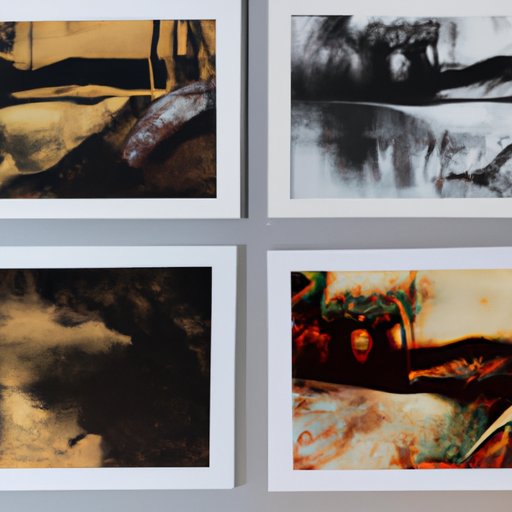Introduction
The world of art prints can be quite confusing for those unfamiliar with the different types of printing processes used to create them. Two of the most popular printing methods used today are giclee prints and art prints. But what is the difference between these two?
Giclee prints are high-quality inkjet prints that use fade-resistant archival inks. They are produced on a wide variety of substrates such as canvas, watercolor paper, or photo paper. Art prints, on the other hand, are created using traditional printing methods such as lithography or serigraphy. These prints are usually printed on paper or cardstock.
In this article, we’ll explore the differences between giclee prints and art prints, including the quality of materials used, the process used for printing, cost, color accuracy, and more. We’ll also discuss the benefits of investing in a giclee print over an art print.

Comparison of Giclee Prints vs. Art Prints
Let’s start by taking a look at some of the key differences between giclee prints and art prints.
Quality of Materials
The quality of materials used is one of the major differences between giclee prints and art prints. Giclee prints are typically produced using high-quality archival inks, which are designed to resist fading over time. Art prints, on the other hand, are usually printed using dye-based inks, which tend to fade more quickly than archival inks.
Process Used for Printing
Another difference between giclee prints and art prints is the process used for printing. Giclee prints are produced using an inkjet printer, while art prints are produced using traditional printing methods such as lithography or serigraphy. While both processes can produce high-quality prints, the process used for printing can have an impact on the final product.
Cost
The cost of giclee prints and art prints can vary depending on the size, material, and complexity of the print. Generally speaking, giclee prints tend to be more expensive than art prints due to the higher quality materials and process used for printing.
Color Accuracy
When it comes to color accuracy, giclee prints tend to be superior to art prints. This is because giclee prints are produced using archival inks, which are designed to accurately reproduce colors from the original artwork. Art prints, on the other hand, are usually printed using dye-based inks, which may not always accurately reproduce colors from the original artwork.
Benefits of Investing in a Giclee Print Over an Art Print
Giclee prints offer several advantages over art prints, making them a great choice for those looking for a high-quality print that will last for years to come.
Durability
One of the main benefits of investing in a giclee print is its durability. Giclee prints are produced using archival inks, which are designed to resist fading and discoloration over time. This makes them ideal for those looking for a print that will last for many years.
Archival Inks
Giclee prints are also produced using archival inks, which are designed to accurately reproduce colors from the original artwork. This ensures that the colors in your print will stay true to the original artwork for many years to come.
Vibrant Colors
Finally, giclee prints tend to have more vibrant colors than art prints. This is because giclee prints are produced using archival inks, which are designed to produce brighter, more vivid colors than dye-based inks.

Exploring the Differences Between Giclee Prints and Art Prints
Now that we’ve discussed the benefits of investing in a giclee print over an art print, let’s take a look at some of the other differences between giclee prints and art prints.
Limited Editions
Giclee prints are often produced as limited editions, meaning there are only a certain number of prints available. This makes them a great choice for collectors who want to invest in a unique piece of art.
Signatures
Giclee prints are often signed by the artist, making them a great way to add value to your collection. Art prints, on the other hand, are usually unsigned.
Paper Types
Giclee prints can be printed on a variety of paper types, including canvas, watercolor paper, or photo paper. Art prints, on the other hand, are usually printed on paper or cardstock.
An In-Depth Look at the Quality of Giclee Prints vs. Art Prints
Now that we’ve explored the differences between giclee prints and art prints, let’s take a closer look at the quality of each type of print.
Ink Permanence
One of the key factors that affects the quality of a print is the permanence of the ink. Giclee prints are produced using archival inks, which are designed to resist fading and discoloration over time. Art prints, on the other hand, are usually printed using dye-based inks, which may not last as long.
Resolution
The resolution of a print is another factor that affects the quality of a print. Giclee prints are usually produced using high-resolution printers, which ensure that the details of the artwork are accurately reproduced. Art prints, on the other hand, are usually printed using lower-resolution printers, which may not accurately reproduce the details of the artwork.
Sharpness
The sharpness of a print is yet another factor that affects its quality. Giclee prints are usually sharper than art prints, due to the higher resolution of the printer used to produce them. This ensures that the details of the artwork are accurately reproduced.
Conclusion
Giclee prints and art prints are both popular options for creating high-quality prints of artwork. While both types of prints have their advantages and disadvantages, giclee prints tend to be superior in terms of quality, color accuracy, and longevity. For those looking for a high-quality print that will last for many years to come, giclee prints are a great choice.
(Note: Is this article not meeting your expectations? Do you have knowledge or insights to share? Unlock new opportunities and expand your reach by joining our authors team. Click Registration to join us and share your expertise with our readers.)
